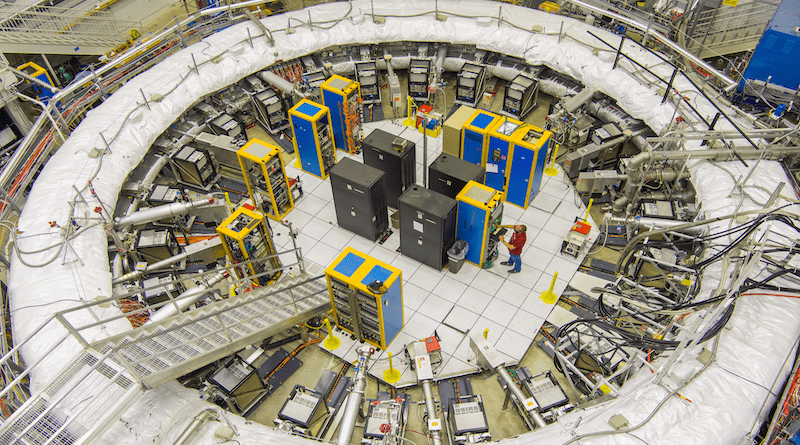New Particles In Universe? Physicists Improve Measurement Technique In Quest To Find New Physics
Could a closer look at the behavior of muon particles lead us to discover hidden physics? In the second part of the muon g-2 experiment, an international team of scientists from Fermilab (Illinois, USA) announced their long-awaited, improved measurement result: In searching for the reason behind the promisingly unusual behavior of the muon, they were able to double their measurement accuracy. From TU Dresden, Prof. Dominik Stöckinger (Director of the Institute for Nuclear and Particle Physics) and his wife Dr. Hyejung Stöckinger-Kim have been accompanying the theoretical foundation of this mammoth project since its conception in 2017.
Muons are elementary particles that gyrate like spinning tops when they pass through a magnetic field. The speed of this gyration depends on the strength of their internal magnetic moment, g-2. Since 2017, Fermilab in Illinois has been producing and studying muons in large numbers in their particle accelerator. Traveling at almost light speed, they are forced through the accelerator ring in a vacuum at -230°C, which is a temperature colder than the surface of Neptune. April 2021 marked their breakthrough discovery. The muon behaved differently than expected in high-precision measurements in comparison with the standard model – but what does this all mean? This could herald the discovery of a new type of physics. Because, since August 2023, we can say for certain: There was no mistake made during the experiment.
Who is the dancer in the dark?
Prof. Stöckinger and Dr. Stöckinger-Kim have been involved in the calculations of the muon g-2 experiment since the outset. “The behavior of the muon can be predicted by the g-factor. It is captured in the standard model of particle physics, which is the globally accepted model for explaining interactions between particles,” explains Dr. Stöckinger-Kim. If we look beyond the standard model, we are presented with a world of new physics.
Her husband continues: “The gyroscopic motion of the muon is different depending on which particles are in its immediate environment. You could say that the muon dances with the other particles that we recognize. For the past 20 years, calculations and measurements have become ever more accurate. If we concentrate on the hypotheses of new physics, we know that particles of dark matter or additional Higgs particles, for example, could influence the value of g-2. Calculations performed at TU Dresden allow conclusions to be drawn about the properties of these potential particles.”
Systematic errors ruled out
We have been able to measure the anomalous magnetic moment of the muon, designated “g-2,” more precisely than ever before. The most recent publication by the researchers involved also underlines that the experiment set up is error-free. Through the intense data evaluation of the last few years, uncertainties could be reduced to the minuscule value of 1:5 million.
The theoretical calculation within the framework of the standard model must now reach a corresponding accuracy in order to allow reliable conclusions on possible new physics to be drawn. International efforts are already underway to achieve this. It still remains unclear as to whether the properties of muons can be fully understood through interactions with photons, electrons, quarks, neutrinos, gluons, W, Z or Higgs bosons, or whether something hidden is acting on the muon.
Hidden subatomic forces
Fermilab plans to evaluate all six years of measurements by 2025 in order to further reduce statistical uncertainties. At the same time, theoretical physicists will improve calculations within the framework of the standard model. “
For a number of reasons, we are certain that our current understanding of physics is incomplete. There could be additional particles or hidden subatomic forces,” says Prof. Stöckinger. The complexity of interpreting this data has increased. As have the computational difficulties involved in the framework theory. However, Dr. Stöckinger-Kim is certain: “The evaluation could open the door to exciting new areas of science.”

